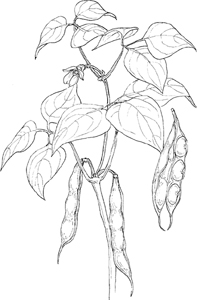
BOTANICAL NAME: Phaseolus vulgaris
FAMILY: Fabaceae

This is a bean that lost its original name but regained the one here by virtue of its distribution through the Maine Seed Saving Network. The network acquired the bean from Antoine d’Avignon of Pintendre, Quebec; he in turn acquired it from the Cantin family of Ct. Portneuf, Quebec, where they have been growing it for some four generations. But since the Cantin family did not know what it was called, Monsieur d’Avignon dubbed the bean Heritage d’Ore (golden heirloom bean; pronounced harry-TAJ door) due to its beautiful color. Its golden, mustard-yellow seeds are indeed eye catching, but best of all this is one of the most delicious baking beans grown in French Canada.
The Heritage d’Ore is a bush bean that benefits from staking due to its two-foot runners. The large, fat pods can be used as snap beans, but like others of its tribe it is best as a soup bean. I mention tribe because this bean belongs to a group of beans that are all closely related: the so-called Hutterite soup bean (greenish-white seed); the white marrowfat bean or pea bean (white seed); and the old Canada Bush (flesh-colored seed), now commonly sold as Worcester Indian. These are among some of the oldest bush varieties brought under cultivation in Europe and they very quickly evolved into several types with distinctive colors. The Heritage d’Ore is actually a strain or selection of an old yellow cranberry bean called China Yellow, first mentioned in Christian Reichart’s Land-und Garten-Schatz in 1821 and then later by Léon-Claude Noisette in his Manuel du jardinier (1825 edition). It is still possible to buy this bean in France under the name coco jaune de la chine. This name does not imply that the bean came from China, but that it is a pure Nankeen yellow in color.
My Canadian friends tell me that the best way to bake this bean is to mix it with ham or game stock and to sweeten it with a little maple syrup rather than molasses. It struck me that the brilliant yellowness of this bean might also be used to advantage in creamy soups flavored with saffron and leek (try the Jaune du Poitou on page 117). Add a little white wine and you have the perfect soup to greet an appetite worked up by an active day of skiing.